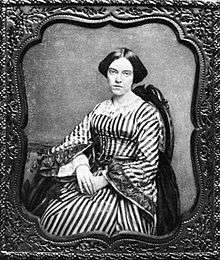Elizabeth Drew Stoddard

Elizabeth Drew Stoddard, née Barstow (May 6, 1823 – August 1, 1902), was a United States poet and novelist
Biography
Elizabeth Stoddard was born Elizabeth Drew Barstow in the small coastal town of Mattapoisett, Massachusetts. She studied at Wheaton Seminary, Norton, Massachusetts. After her marriage in 1852 to poet Richard Henry Stoddard, the couple settled permanently in New York City, where they belonged to New York's vibrant, close-knit literary and artistic circles. She assisted her husband in his literary work, and contributed stories, poems and essays to the periodicals. Many of her own works were originally published between 1859 and 1890 in such magazines as The Aldine, Harper's Monthly, Harper's Bazaar, and The Atlantic Monthly.
Writing style and criticism
_Poems.jpg)
Stoddard is most widely known today as the author of The Morgesons (1862), her first of three novels. Her other two novels are Two Men (1865) and Temple House (1867). Stoddard was also a prolific writer of short stories, children's tales, poems, essays, travel writing, and journalism pieces.
Her work combines the narrative style of the popular nineteenth-century male-centered bildungsroman with the conventions of women's romantic fiction in this revolutionary exploration of the conflict between a woman's instinct, passion, and will, and the social taboos, family allegiances, and traditional New England restraint that inhibit her.
Her most studied work, The Morgesons is set in a small seaport town, and is the dramatic story of Cassandra Morgeson's fight against social and religious norms in a quest for sexual, spiritual, and economic autonomy. An indomitable heroine, Cassandra not only achieves an equal and complete love with her husband and ownership of her family's property, but also masters the skills and accomplishments expected of women. Counterpointed with the stultified lives of her aunt, mother, and sister, Cassandra's success is a striking and radical affirmation of women's power to shape their own destinies. Embodying the convergence of the melodrama and sexual undercurrents of gothic romance and Victorian social realism, The Morgesons marks an important transition in the development of the novel and evoked comparisons during Stoddard's lifetime with such masters as Honoré de Balzac, Leo Tolstoy, George Eliot, the Brontë sisters, and Nathaniel Hawthorne.[1]
One major source of Stoddard's importance to American literature is the historicism of her work, the manner in which her writing embodied and subverted the tension of her present-day culture with the archetypal or received values of the American past. A pioneering predecessor of regionalist authors Mary Eleanor Wilkins Freeman, Sarah Orne Jewett, and Kate Chopin, as well as a precursor of American modernism, Stoddard's writing is remarkable for its almost total lack of sentimentality, pervasive use of irony, psychological depth of richly drawn characters, intense atmospheric descriptions of New England, concise language, and innovative use of narrative voice and structure. Her investigation of relations between the sexes, a dominant focus of her fiction, analyzes emotions ranging from love and desire to disdain, aggression, and depression.
References
- ↑ Habegger, Alfred (1989). Henry James and the "Woman Business", p. 95. Cambridge University Press.
Further reading
- Stoddard, Elizabeth (1997). The Morgesons. Toronto: Penguin Classics. ISBN 0-14-043651-0.
- Stoddard, Elizabeth: The Morgesons and other writings : published and unpublished, Ed., with an crit. introd. by Lawrence Buell and Sandra A. Zagarell, Philadelphia, Pa. : PENN, Univ. of Pennsylvania Pr., 1996, ISBN 0-8122-7924-7
- Stoddard, Elizabeth (2008). Two Men. Lincoln: University of Nebraska Press. ISBN 080329347X.
- Felker, Christopher D. (1993). Reinventing Cotton Mather in the American Renaissance: Magnalia Christi Americana in Hawthorne, Stowe, and Stoddard. Boston: Northeastern University Press. ISBN 1-55553-187-3.
- Opfermann, Susanne (2003). Stories. Boston: Northeastern University Press. ISBN 1-55553-562-3.
- Putzi, Jennifer (2000). Tattooed still: The Inscription of Female Agency in Elizabeth Stoddard's The Morgesons" Legacy. 17, Number 2. University of Nebraska Press. pp. 165–173.
- Moss, Elizabeth (1992). Domestic Novelists in the Old South. baton Rouge: Louisiana State University Press. ISBN 0-8071-2796-5.
- Smith, Robert McClure and Ellen Weinauer, eds. American Culture, Canons, and the Case of Elizabeth Stoddard. Tuscaloosa: U of Alabama P, 2003
- Stockton, Elizabeth. “ ‘A Crusade against Duty’: Property, Self-Possession, and the Law in the Novels of Elizabeth Stoddard.” The New England Quarterly 79.3 (2006): 413-438.
External links
| Wikiquote has quotations related to: Elizabeth Drew Stoddard |
| Wikisource has original works written by or about: Elizabeth Stoddard |
- Works by Elizabeth Stoddard at Project Gutenberg
- Works by or about Elizabeth Drew Stoddard at Internet Archive
- Works by Elizabeth Drew Stoddard at LibriVox (public domain audiobooks)

- PAL: Perspectives in American Literature